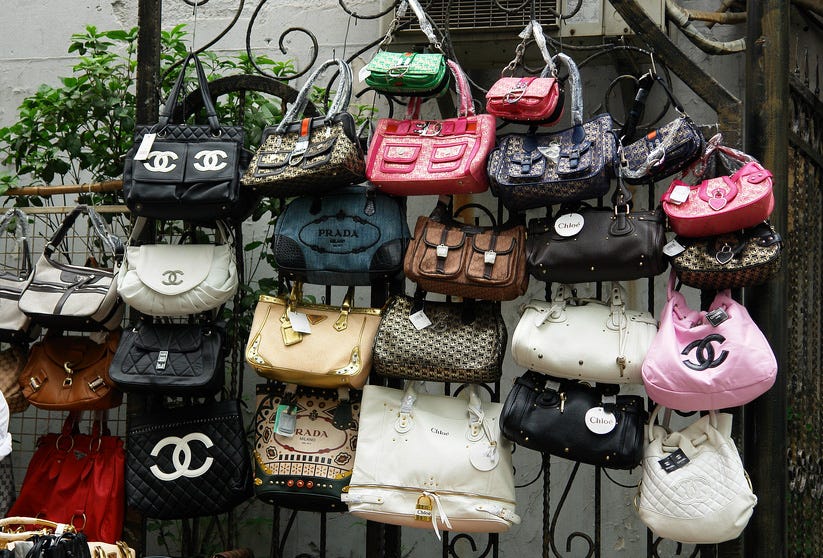The Caricature And Copycat Nature of Fake Luxury
When the fakes are that good, you don’t want the real thing
I have exciting news to share: You can now read Fashion Tingz in the new Substack app for iPhone!

I encountered my first luxury counterfeit piece when I strolled into a popular New York vintage store on a solo trip back in 2018. Behind the counter, just out of reach for customers but still within plain sight, was an array of wannabe tie-dye Gucci t-shirts that weren’t too dissimilar to something you’d see in Gucci’s Fifth Avenue boutique. They were displayed proudly and exclusively, apart from the rest of the vintage merch as if they needed a designated section due to the prestige of the brand name alone. But everyone who walked into that store would know they weren’t real, and anyone who purchased such an item would know that they were buying a fake - but that didn’t seem to stop them.
Fakes, knockoffs, counterfeits, replicas or dupes as they’re known among today's crowd, manage to hold a certain amount of allure and desirability. We buy into luxury brands because of the status they represent, and the lifestyle that they signal to others we have. But the price tag is unaffordable and a joke given today's cost of living crisis which is leading more and more people to dip their toes into the world of fake luxury. Faking clothing, shoes, bags and accessories is easier in the world of fashion than it is in a lot of other industries such as tech and electronics. Unphased counterfeiters just copy and paste the logo, look and style of a big boy brand and bam, there you have your copycat product ready to be snapped up by a swarm of eager buyers.
Even though there's been significant development in luxury goods being able to be properly authenticated, with anti-counterfeiting tools such as QR codes, RFID (radon’s frequency identification) tags, security numbers, engraved markings and holograms being used across genuine luxury buys, this doesn’t seem to deter the flow of counterfeits and lookalike luxury goods flooding the market. This year the global counterfeiting industry is expected to hit around $4.2 trillion, and a recently published article in The Guardian suggests that counterfeits have increased by 10,000% in just two decades. Given the current state of the world buying into the caricature copycat fake luxury is becoming a rebellious way for consumers to say to brands, “you can stick it where the sun doesn't shine”. And who can blame them?
The rise of good fakes
The desire for a wardrobe full of logo-heavy items leads people to do crazy things. Where once you used to have to head down to Canal Street in Manhattan or Camden Town in London to haggle the price over a fake Louis Vuitton or Chanel handbag, now luxury brand knockoffs are available at the click of a button. No longer relegated to market stalls or shady side streets and cobbled alleyways, the introduction of the internet and the rise of e-commerce has meant that savvy shoppers can peruse counterfeit goods to their heart's desire from the comfort of their own homes. Think cup of tea in hand, a chocolate bar on the go all cosy enveloped in a blanket on the sofa, click click clicking away and scouring online sites for the best fake bargains.
If people can buy an almost identical style of an item to its luxury counterpart, that comes at a high standard but for a fraction of the price, without ever having to step outside of their front door and run the risk of a counterfeit seller getting raided and whisked away by police, wouldn’t common sense make them add to basket? The fakes have become so good and so advanced that even rich people, who could easily spend thousands of pounds on genuine luxury, have been spotted mixing fakes with the real thing. And that’s how you know it’s a big deal. How to find fashionable dupes and designer copycats on sites like Amazon and DHGate has even become a popular form of video on TikTok. TikTokers unveil their oh-so-glamorous-yet-affordable purchases in the usual unboxing video trope, spilling the tea and letting the people know where to get the goodies. And the people want to know.
Comment sections are bombarded with questions, queries, and users trading secrets and buying tips with others, with the shared sense of community built around fake goods almost heart-warming. Almost. But that doesn’t mean luxury brands haven’t got a case of the green-eyed monster with the rise of good fakes. And how are they reacting I hear you ask? Well, contrary to popular belief, some are adopting the ‘if you can’t beat them join them’ mindset. And Gucci is one said brand. For its 2018 Cruise collection logomania took over, but not in the way you might think. Models strode down the runway clutching bags and purses with “Guccy” worn loud and proud, with the same brand name wordplay seen across jumpers and t-shirts. Instead of being a huge design team error (can you imagine the sheer terror that would instil Gucci’s holding company Kering), it was Gucci poking fun at counterfeiters that attempt to avoid legal ramifications by misspelling the brand name. Gucci 1 - counterfeiters 0.
Buying fakes as an act of protest // a DIY mentality
Glossy ad campaigns, clever PR strategies, and partnering with the right influencer or celeb at the right time conjures the cool factor for many luxury brands. But brands have become increasingly desperate to protect their reputation against the counterfeit market, with some even going as far as to burn old stock to retain their high-end image and brand identity. The deeper you dig into the world of counterfeit luxury goods, the more you realise there are complex associations behind the rise in their purchase popularity than you may have originally thought. Not only are fakes a way for people to connect with designer aesthetics, looks and vibes more affordably, but buying fakes has become an act of protest.
The nature of fakes mocks and undermines the exclusive and elitist world luxury operates in. And by buying fake goods, consumers are questioning the values, policies and ethics of the luxury brands people are so desperate to buy into by playing the system and taking away their power, and speeding their hard-earned dollars elsewhere. As a Millennial I come from a generation that's lived through the 2008 crash and is currently living through an ongoing pandemic, European war and cost of living crisis, not to mention several other world crises that affect how much disposable income people have and where they choose to spend it. So for me, it's easy to see why people are buying fake goods as a way to be smarter with money. Don't get me wrong I'm not saying it's the right thing to do, but I can see the reasoning behind it.
Something that sticks out to me, given most people's current financial situations, is as a way to batten down the hatches and tighten purse strings when it comes to fashionable spending, people are adopting a DIY mentality and taking matters into their own hands by making copycat luxe goods themselves. Instead of paying £300 or more for a basic high-end t-shirt, creativity has taken over and people are expanding the idea of what a counterfeit item can be by completely parodying it. And some of the results are good, really good, so much so that I've added a couple of pieces to my wish list. It's clear that counterfeit goods aren’t going to go anywhere anytime soon, but the way we engage and interact with them is always subject to change.
What are your thoughts on the luxury counterfeit market? Would you buy fake luxury goods, and if yes/no, why? Spill the tea, I want to hear from you.
Share this post, feel free to comment, and subscribe to Fashion Tingz to keep the conversation going.








